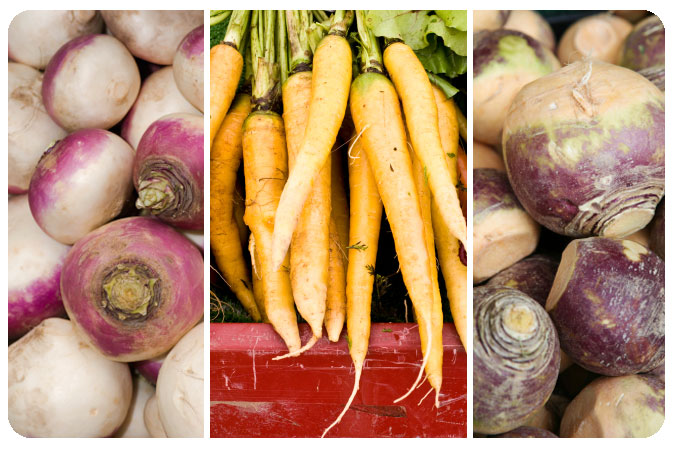Last winter, I was at a brand new organic market in Denver, CO, stocking up to cook dinner for my friends. I had a nice local pork roast in my cart when I stumbled on their lovely bulk spices. So I sniffed and scooped and soon had the makings of a Spiced Pork Roast that, in my mind, was already sitting beside a caramely, burnished roasted root vegetable medley. So into the cart went a turnip, a couple of parsnips, a rutabaga and a knobby celery root.
I thought nothing of those humble root vegetables, other than how scrumptious they'd be with the pork, yet when I lifted them onto the checkout belt everyone in line–including the checker–looked at me as if I were holding a baby wallaby.
“Wow, you're making some kind of fancy dinner, eh?” the checkout woman said.
I was stumped. “You mean these?” I pointed to my cart. “These are just root vegetables.”
“Well I've never seen them before,” she countered, and was seconded (and thirded and fourthed) by others in line. So I gave them a quick run down on root veggies (and a NOURISH Evolution card … hee hee) and they promised to venture beyond potatoes on their next visit to the market.
The irony is, root vegetables are about the most common, hardy vegetable group out there. Yet they are nutritional powerhouses, mighty tasty and refreshingly inexpensive.
So if you were in line behind me in Denver last year, or if you're just curious about root vegetables, this roundup is for you:
- Parsnips — Parsnips look like a pale, creamy carrot that's a bit stouter at the shoulders and more tapered at the tip. They're earthy-sweet and nearly as starchy as potatoes, and are a great source of vitamins C, K and folate, and the mineral manganese. Choose smaller ones (large parsnips can be quite woody inside), then peel and cube for a roast, mash, puree or fries.
- Carrots — Carrots are ubiquitous on grocery store shelves, yet in nature they come in a variety of sizes, colors and flavors. All carrots, though, are packed with vitamin A from beta carotene. Carrots excel both raw (they're delicious grated into a salad), roasted or in soup. The fresher the carrots, the sweeter and juicier they'll be.
- Turnips — Turnips may sound frumpy, but, when young, they're tender and sweet. Look for small ones with firm, pearly white skin and try them in our White Bean and Kale Ragout with Turnips and Sausage. Swap out the kale for the turnip greens for a bit more zip (they've got a nose-tingling, mustardy flavor), and a big boost of vitamins A and K to turnip root's C.
- Rutabagas — Rutabagas are similar to turnips (they're actually a cross between cabbage and turnip), but have more of a yellowish hue and a violet rim, whereas turnips are white with a scarlet nape. Rutabagas are more fibrous than turnips and slightly sweeter and, like turnips, are a great source of vitamin C. Choose firm ones no bigger than a softball for roasts and mashes.
- Beets — Beets are beautiful. They range in hue from the aptly named Bull's Blood to golden to the candy-striped chiogga and in flavor from earthy to downright sweet. Beets are higher in both fiber and sugar than other root vegetables, and are a decent source of folate, potassium and manganese. Peel beets to use them raw in salads or cubed in a roast. Or boil or roast them skin-on and remove skins after cooking.
- Sweet Potatoes — Sweet potatoes are sweet and creamy and complex and versatile, and are busting at the seams with vitamin A. I often use them as a stand-in for squash or pumpkin when I'm not up for peeling and seeding. They're terrific in a roast, as fries, as a puree and even a pie.
- Celery Root — Celery root, or celeraic, is omnipresent in France, where it shows up in salads and soups nearly everywhere. It's a big, gnarly ball of a vegetable that's a bit tough to peel. But once you do you'll be rewarded with an earthy, almost herbal flavor that comes through whether raw, roasted, pureed or mashed.
- Radishes — I think we take radishes for granted here in America. They're like little gems, with a crisp, spicy bite that mellows under heat; I find them a refreshing cool-winter alternative to warm-weather cucumbers. Choose firm radishes with a healthy sheen and no cracks, and slice them into salads or on a sandwich, or venture into new territory and saute them in brown butter with mint.













